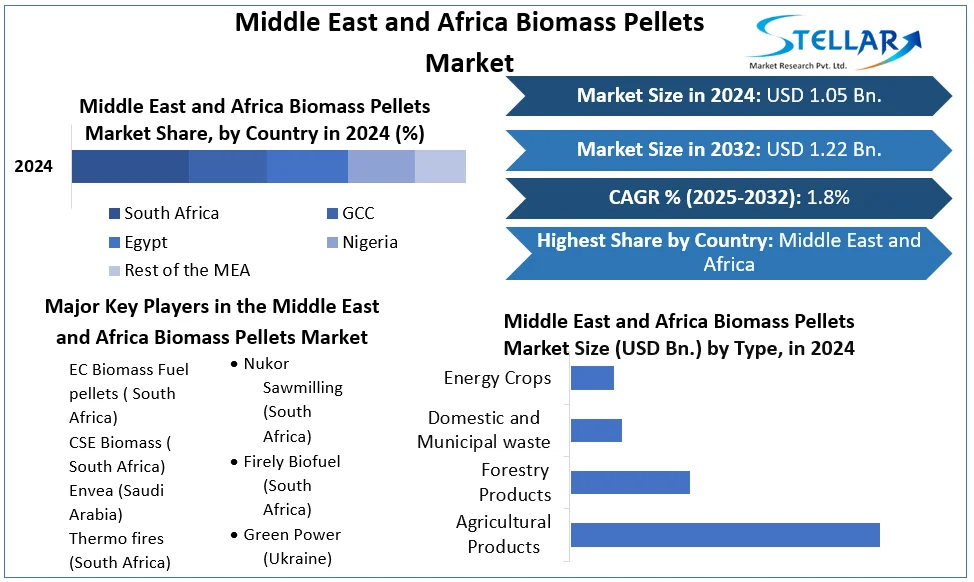Middle East and Africa Biomass Pellets Market Industry Overview, Size, Share, Growth Trends, Research Insights and Forecast (2025–2032)
Middle East and Africa Biomass Pellets Market was valued at USD 1.05 billion in 2024. The Middle East and Africa Biomass Pellets Market size is estimated to grow at a CAGR of 1.8 % over the forecast period.
Format : PDF | Report ID : SMR_803
Middle East and Africa Biomass Pellets Market Definition:
Biomass pellets generate electricity and heat, increasing demand from the power industry, which is expected to increase biomass pellet use. Biomass pellets are extremely dense and may be made with low moisture content, allowing for high combustion efficiency when burned. Agricultural waste, wood sawdust, and other biomass materials are used to make biomass pellets.
Further, the Middle East and Africa Biomass Pellets market is segmented by type, application, and geography. On the basis of type, the Middle East and Africa Biomass Pellets market is segmented under Agriculture products, Forestry products, Domestic and Municipal Waste, and Energy. Based on the Application, the market is segmented under Woodies, Herbs, and Others. By geography, the market covers the major countries in Middle East and Africa i.e., South Africa, Nigeria, Saudi Arabia, UAE, Kuwait, Egypt and Rest of Middle East and Africa For each segment, the market sizing and forecasts have been done on the basis of value (in USD Billion).

To get more Insights: Request Free Sample Report
Middle East and Africa Biomass Pellets COVID 19 Insights: The COVID-19 outbreak has had a major impact on the market, resulting in a drop in overall demand. Most end-use sectors have experienced a major reduction as a result of the economic slowdown and temporary shutdown of industrial bases, which is likely to have a negative impact on the biomass pellets market in the early years of the forecast period. When compared to other industrial sectors, the supply chain has been considerably less disrupted during the pandemic, which is a positive feature for the biomass pellets market.
Middle East and Africa Biomass Pellets Market Dynamics:
Market Drivers:
Africa's forest resources are rapidly depleting. Over the last decade, forest loss has increased by an average of 3.9 million hectares every year. Wood pellets and biomass pellets made from the abundant agriculture, crop, and timber residues are seen as a sustainable solution to generate bio-energy, enhance local economies, and satisfy overall energy needs while also protecting forests.
Biomass provides for over 85% of renewable energy. Biomass is nearly entirely used to generate heat (residential and in the industry). The total energy supply is driven by coal. It generates 92 %of South Africa's electricity and 57 %of its heat.
The growing usage of wood pellets in power generation across the region is another important market driver. Furthermore, the market is being propelled forward by wood pellets' high combustion efficiency. This, combined with rising oil prices and the increased utilization of wood pellets to heat federal and municipal buildings, office buildings, and educational facilities, is creating profitable growth potential for end-users.
Market Opportunity: Moreover, governments and organizations are heavily supporting renewable energy adoption in the residential, transportation, and industrial sectors, providing attractive prospects for market participants between 2024 and 2030. Furthermore, as people become more aware of the benefits of using renewable energy sources, the biomass pellet market will continue to grow in the future.
Market Challenges: The lack of information about the benefits of the product, as well as its cost-effectiveness, will hinder the growth of the biomass pellet market. However, market growth is likely to be hampered throughout the forecast period due to the increasing adoption and deployment of alternative renewable energy sources such as solar photovoltaic, wind energy, and geothermal in various areas of the region.
Middle East and Africa Biomass Pellets Market Segment Analysis:
By Type, Biomass pellets are mostly made from agricultural products. Biomass pellets are made from agricultural waste such as straws, husks, and other materials. The significant amount of lignin and cellulose in these agricultural residues aids in the binding of the pellets together. Agricultural residues are a sustainable and renewable resource that can be used to generate electricity without polluting the environment.
Forestry products include both wood and non-wood products produced from forests. Timber, fuelwood, charcoal, paper, and pulp are among them. Non-timber Forest Products (NTFPs), such as fruits, nuts, medicinal plants, resins, and spices, are also included in forestry products. The materials derived from felled and processed trees are known as forestry products, sometimes known as timber.
The biodegradable fraction of garbage originating from households and similar sources such as schools, hospitals, and business buildings is referred to as domestic and municipal waste. It might be affected by water or non-putrescible in nature. Kitchen waste is included in the first category, whereas paper, glass, metal, and plastic waste are included in the second. In many areas, municipal solid waste (MSW) is a substantial source of biomass fuel.

By Application, Woodies are one of the most popular biomass pellet applications. Woodies are little, spherical bits of wood used as firewood and grill fuel. Biomass pellets can be manufactured from a wide range of wood species, including hardwoods and softwoods. Pellets created from hardwoods like oak or hickory provide more heat than pellets made from softwoods like pine or fir.
Dry herbs can benefit from the use of biomass pellets as a heat source. The heat from the pellets will help preserve the essential oils in the herbs and keep them from deteriorating. Pellets can also be used to flavor oils and vinegar with herbs. Rosemary and sage are two popular herbs that can be flavor-infused with biomass pellets. You can make your unique mixtures of herb-infused oils and vinegar with biomass pellets to add flavor to your dishes
Middle East and Africa Biomass Pellets Market Key Players Insights:
The market is characterized by the existence of a number of well-known firms. These companies control a large portion of the market, have a wide product portfolio, and have a global presence. In addition, the market comprises small to mid-sized competitors that sell a limited variety of items, some of which are self-publishing organizations.
The market's major companies have a significant impact because most of them have extensive global networks through which they can reach their massive client bases. To drive revenue growth and strengthen their positions in the Middle East and Africa market, key players in the market, particularly in this region, are focusing on strategic initiatives such as acquisitions, new collection launches, and partnerships.
The objective of the report is to present a comprehensive analysis of the Middle East and Africa Biomass Pellets market to the stakeholders in the industry. The report provides trends that are most dominant in the Middle East and Africa Biomass Pellets market and how these trends will influence new business investments and market development throughout the forecast period. The report also aids in the comprehension of the Middle East and Africa Biomass Pellets Market dynamics and competitive structure of the market by analyzing market leaders, market followers, and regional players.
The qualitative and quantitative data provided in the Middle East and Africa Biomass Pellets market report is to help understand which market segments, and regions are expected to grow at higher rates, factors affecting the market, and key opportunity areas, which will drive the industry and market growth through the forecast period. The report also includes the competitive landscape of key players in the industry along with their recent developments in the Middle East and Africa Biomass Pellets market. The report studies factors such as company size, market share, market growth, revenue, production volume, and profits of the key players in the Middle East and Africa Biomass Pellets market.
The report provides Porter's Five Force Model, which helps in designing the business strategies in the market. The report helps in identifying how many rivals exist, who they are, and how their product quality is in the Middle East and Africa Biomass Pellets market. The report also analyses if the Middle East and Africa Biomass Pellets market is easy for a new player to gain a foothold in the market, do they enter or exit the market regularly, if the market is dominated by a few players, etc.
The report also includes a PESTEL Analysis, which aids in the development of company strategies. Political variables help in figuring out how much a government can influence the Middle East and Africa Biomass Pellets market. Economic variables aid in the analysis of economic performance drivers that have an impact on the Middle East and Africa Biomass Pellets market. Understanding the impact of the surrounding environment and the influence of environmental concerns on the Middle East and Africa Biomass Pellets market is aided by legal factors.
Middle East and Africa Biomass Pellets Market Scope:
|
Middle East and Africa Biomass Pellets Market |
|
|
Market Size in 2024 |
USD 1.05 Bn. |
|
Market Size in 2032 |
USD 1.22 Bn. |
|
CAGR (2025-2032) |
1.8% |
|
Historic Data |
2019-2024 |
|
Base Year |
2024 |
|
Forecast Period |
2025-2032 |
|
Segment Scope |
By Type
|
|
By Application
|
|
|
Country Scope |
|
Middle East and Africa Biomass Pellets MARKET KEY PLAYERS:
- EC Biomass Fuel pellets ( South Africa)
- CSE Biomass ( South Africa)
- Envea (Saudi Arabia)
- Thermo fires (South Africa)
- Nukor Sawmilling (South Africa)
- Firely Biofuel (South Africa)
- Green Power (Ukraine)
Frequently Asked Questions
The market size of the Middle East and Africa Biomass Pellets Market by 2032 is expected to reach USD 1.22 Billion.
The forecast period for the Middle East and Africa Biomass Pellets Market is 2025-2032.
The market size of the Middle East and Africa Biomass Pellets Market in 2024 was valued at USD 1.05 Billion.
Middle East and Africa Biomass Pellets Market report helps with the PESTEL, PORTER, COVID-19 Impact analysis, Recommendations for Investors & Leaders, and market estimation of the forecast period.
1. Middle East and Africa Biomass Pellets Market: Research Methodology
2. Middle East and Africa Biomass Pellets Market Introduction
2.1. Study Assumption and Market Definition
2.2. Scope of the Study
2.3. Executive Summary
3. Middle East and Africa Biomass Pellets Market: Dynamics
3.1. Middle East and Africa Biomass Pellets Market Trends
3.2. Middle East and Africa Biomass Pellets Market Dynamics
3.2.1. Drivers
3.2.2. Restraints
3.2.3. Opportunities
3.2.4. Challenges
3.3. PORTER’s Five Forces Analysis
3.4. PESTLE Analysis
3.5. Technology Roadmap
3.6. Value Chain Analysis
3.7. Regulatory Landscape
4. Middle East and Africa Biomass Pellets Market: Market Size and Forecast by Segmentation (by Value in USD Million and Volume Tonnes) (2024-2032)
4.1. Middle East and Africa Biomass Pellets Market Size and Forecast, by Type (2024-2032)
4.1.1. Agricultural Products
4.1.2. Forestry Products
4.1.3. Domestic and Municipal waste
4.1.4. Energy Crops
4.2. Middle East and Africa Biomass Pellets Market Size and Forecast, by Application (2024-2032)
4.2.1. Woodies
4.2.2. Herbs
4.2.3. Others
4.3. Middle East and Africa Biomass Pellets Market Size and Forecast, by Country (2024-2032)
4.3.1. South Africa
4.3.2. GCC
4.3.3. Nigeria
4.3.4. Rest of ME&A
5. Middle East and Africa Biomass Pellets Market: Competitive Landscape
5.1. SMR Competition Matrix
5.2. Competitive Landscape
5.3. Key Players Benchmarking
5.3.1. Company Name
5.3.2. Product Segment
5.3.3. End-user Segment
5.3.4. Revenue (2024)
5.3.5. Company Locations
5.4. Market Structure
5.4.1. Market Leaders
5.4.2. Market Followers
5.4.3. Emerging Players
5.5. Mergers and Acquisitions Details
6. Company Profile: Key Players
6.1. EC Biomass Fuel pellets ( South Africa)
6.1.1. Company Overview
6.1.2. Business Portfolio
6.1.3. Financial Overview
6.1.4. SWOT Analysis
6.1.5. Strategic Analysis
6.1.6. Recent Developments
6.2. CSE Biomass ( South Africa)
6.3. Envea (Saudi Arabia)
6.4. Thermo fires (South Africa)
6.5. Nukor Sawmilling (South Africa)
6.6. Firely Biofuel (South Africa)
6.7. Green Power (Ukraine)
7. Key Findings
8. Industry Recommendations
















